ETX module has Atom, SATA ports
Jul 22, 2009 — by LinuxDevices Staff — from the LinuxDevices Archive — 10 views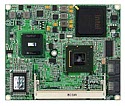 Diamond Systems announced an ETX 3.0-compliant COM (computer on module) offering two SATA interfaces and an Intel Atom N270 CPU. The “ETX-N270” (left) accepts 2GB of RAM, has a 10/100 Ethernet port, offers CRT, LVDS, or TV video output, and runs Linux 2.6, the company says.
Diamond Systems announced an ETX 3.0-compliant COM (computer on module) offering two SATA interfaces and an Intel Atom N270 CPU. The “ETX-N270” (left) accepts 2GB of RAM, has a 10/100 Ethernet port, offers CRT, LVDS, or TV video output, and runs Linux 2.6, the company says.
Like other COMs using the 4.5 x 3.7-inch ETX format — originally devised by Jumptec, and then acquired by Kontron — the ETX-N270 is a module supplying core CPU, memory, display and networking subsystems, and I/O. It plugs into application-specific baseboards, as detailed later in this story, which include standard PC-style connectors.
ETX 3.0, introduced by Kontron in 2006, added two serial ATA (SATA) ports without changing any of the ETX board-to-board pins, keeping new modules 100 percent pin-compatible with previous versions. Since the SATA ports employ "slim line" connectors on the top side of the module, rather than sending signals through the ETX connectors on the bottom, the modules remain compatible with any ETX carrier board.
Accordingly, the only "real world" connectors on Diamond's ETX 3.0-compliant ETX-N270 are the SATA ports (visible, below left), which support one drive apiece, according to the company. Other signals, which include both 32-bit PCI and 16-bit ISA expansion buses, all travel through the module's four ETX connectors (below right).
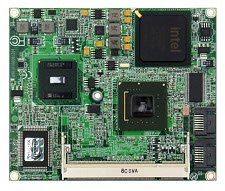
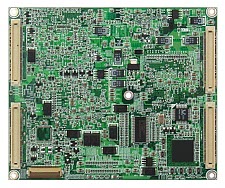
Diamond's ETX-N270
(Click either to enlarge)

A block diagram of Diamond's ETX-N270
(Click to enlarge)
Features and specifications listed by Diamond for the RoHS-compliant ETX-N270 include the following:
- Processor — 1.6GHz Intel Atom N270
- Memory — Up to 2GB of DDR2 RAM via SODIMM slot
- Storage — Includes IDE and two SATA ports
- Display — Supports CRT, LVDS, and SDVO video outputs
- Networking — 1 x 10/100 Ethernet
- Other I/O:
- 4 x USB 2.0
- IDE
- 2 x COM ports
- 2 x PS/2
- Audio — mic in, line in/out
- 1 x parallel (SPP/EPP/ECP or floppy)
- 1 x IrDA
- Expansion:
- PCI
- ISA
- SMbus
- I2C
- Power:
- 5VDC
- TDP — 10 Watts
- Operating temperature — -4 to 158 deg. F(-20 to 70 deg. C)
- Dimensions — 4.5 x 3.7 inches
- Weight — 2.8 ounces (79g)
- Operating system — Linux 2.6; Windows XP
Baseboards
Prior to this week's announcement of its ETX-N270, Diamond Systems already offered a pair of baseboards designed to accept ETX modules and provide them with a variety of real-world I/O. Citing an alliance with Kontron, Diamond initially recommended use of the latter's ETX modules, such as the Atom N270-based ETX-DC. While the Diamond baseboards are presumably still compatible with Kontron modules, release of the ETX-N270 now gives Diamond an ETX module it can "call its own."
The Pluto baseboard, released just last week, shares the ETX-N270's 4.5 x 3.7-inch footprint and is designed to be stacked on top of it. The Pluto accepts PC/104 (ISA), PCI/104 (PCI), or PC/104-Plus (PCIe) expansion modules, and also offers a CompactFlash slot (below left). While the baseboard doesn't add any real-world connectors, a separately available cable set does.
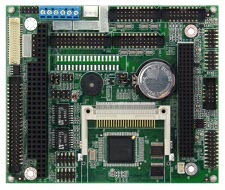
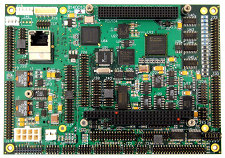
Diamond's Pluto (left) and Neptune (right) baseboards are compatible with the ETX-N270
(Not to scale; click either for further information)

The Neptune's optional panel I/O board provides real-world ports
- 32 analog inputs, 16-bit A/D, 250KHz sample rate
- 4 analog outputs, 12-bit D/A
- 24 digital I/O, 3.3V/5V compatible
- 8 opto-isolated digital inputs, 3-24V range
- 8 opto-isolated digital outputs, 3-24V range
- 2 counter/timers for A/D sample rate control, event counting/timing, and programmable interrupts
The Neptune's autocalibration circuitry permits calibrating the analog circuits under software control at any time, maintaining the best possible accuracy, says Diamond.
Availability
According to Diamond Systems, the ETX-N270 CPU module is shipping now, priced at $325 in single quantities. Operating system support is said to include Linux 2.6 and Windows XP currently, with support for additional OSes and RTOSes being in the works. More information on the ETX-N270 may be found on the Diamond Systems website, here.
This article was originally published on LinuxDevices.com and has been donated to the open source community by QuinStreet Inc. Please visit LinuxToday.com for up-to-date news and articles about Linux and open source.